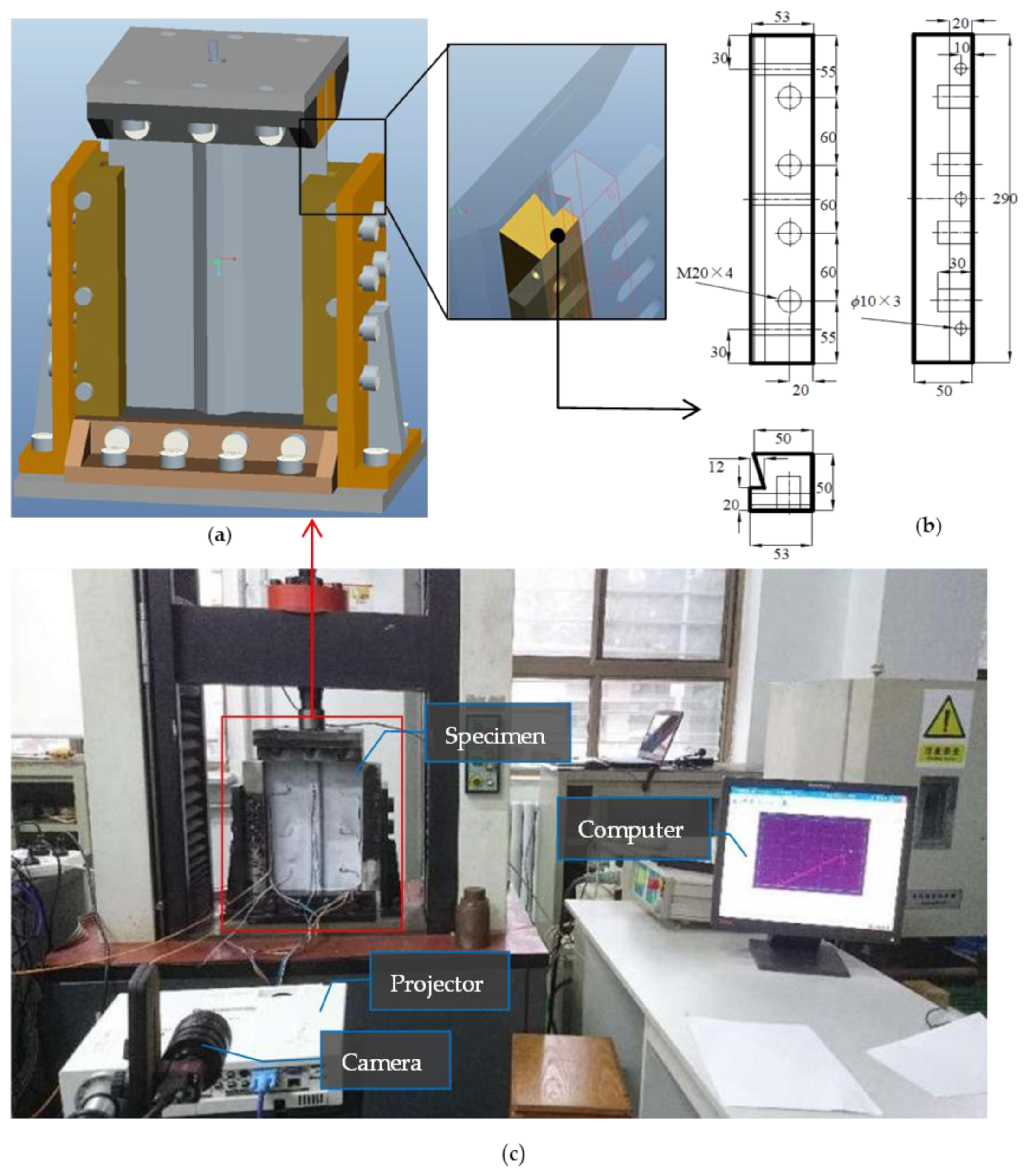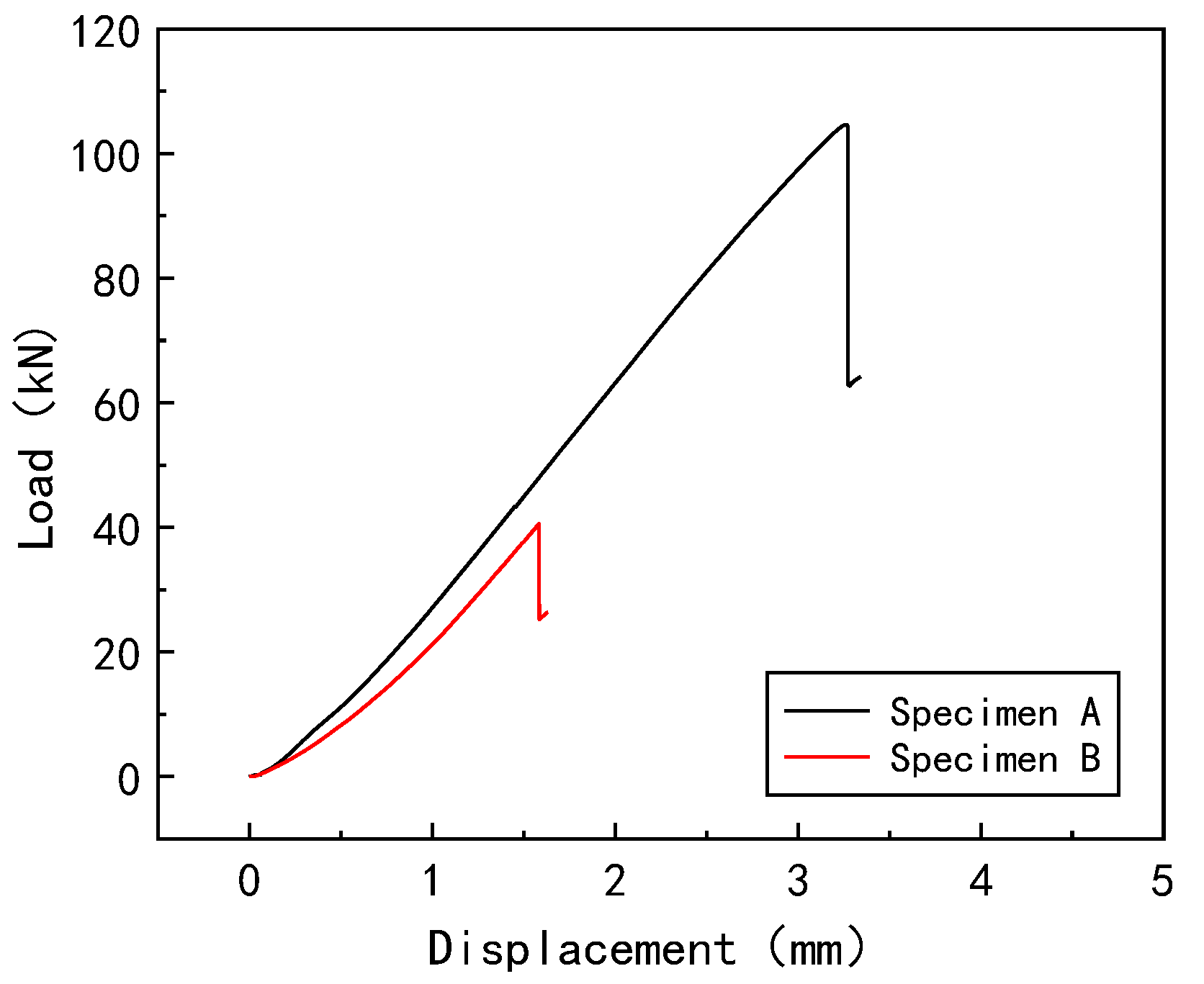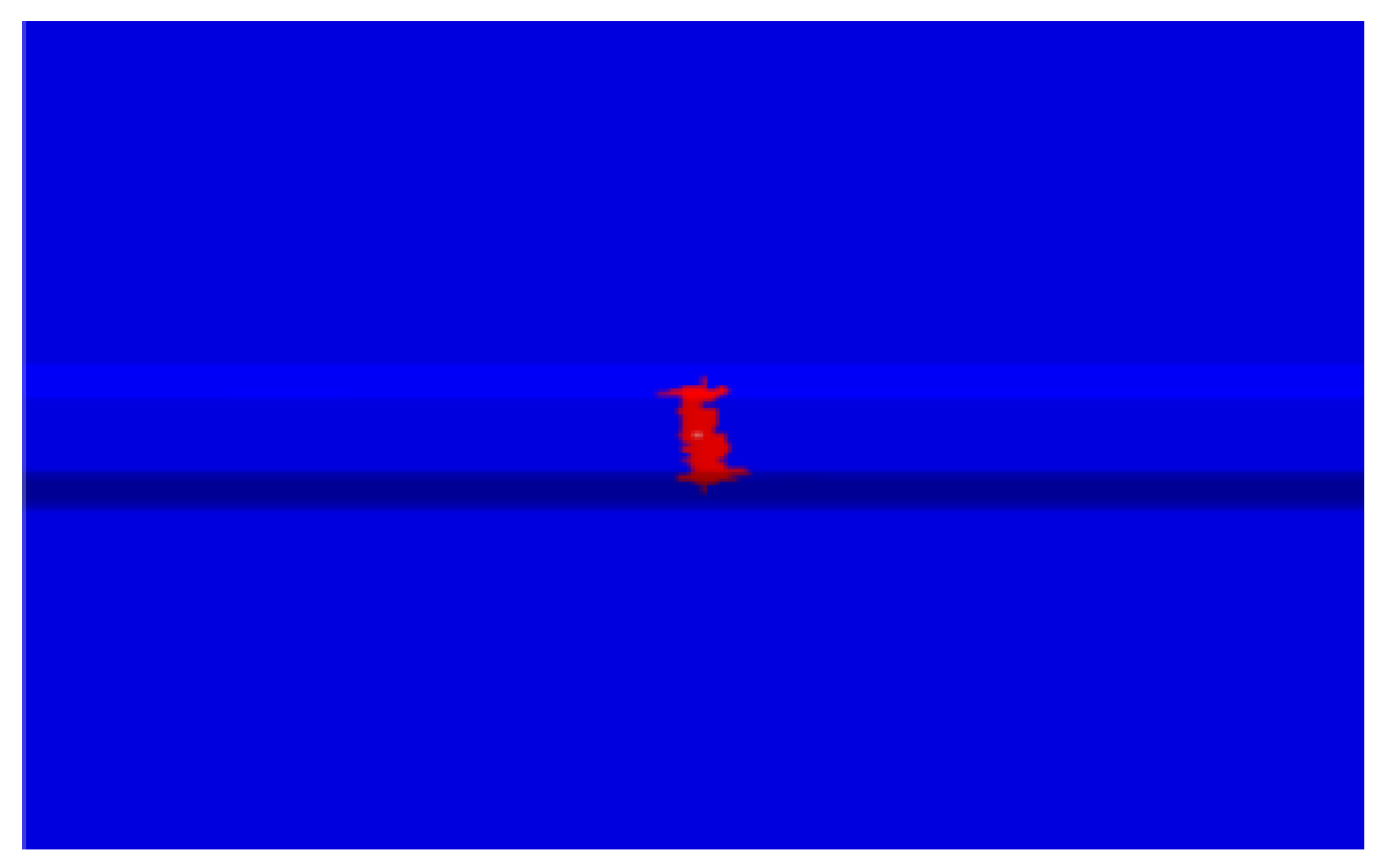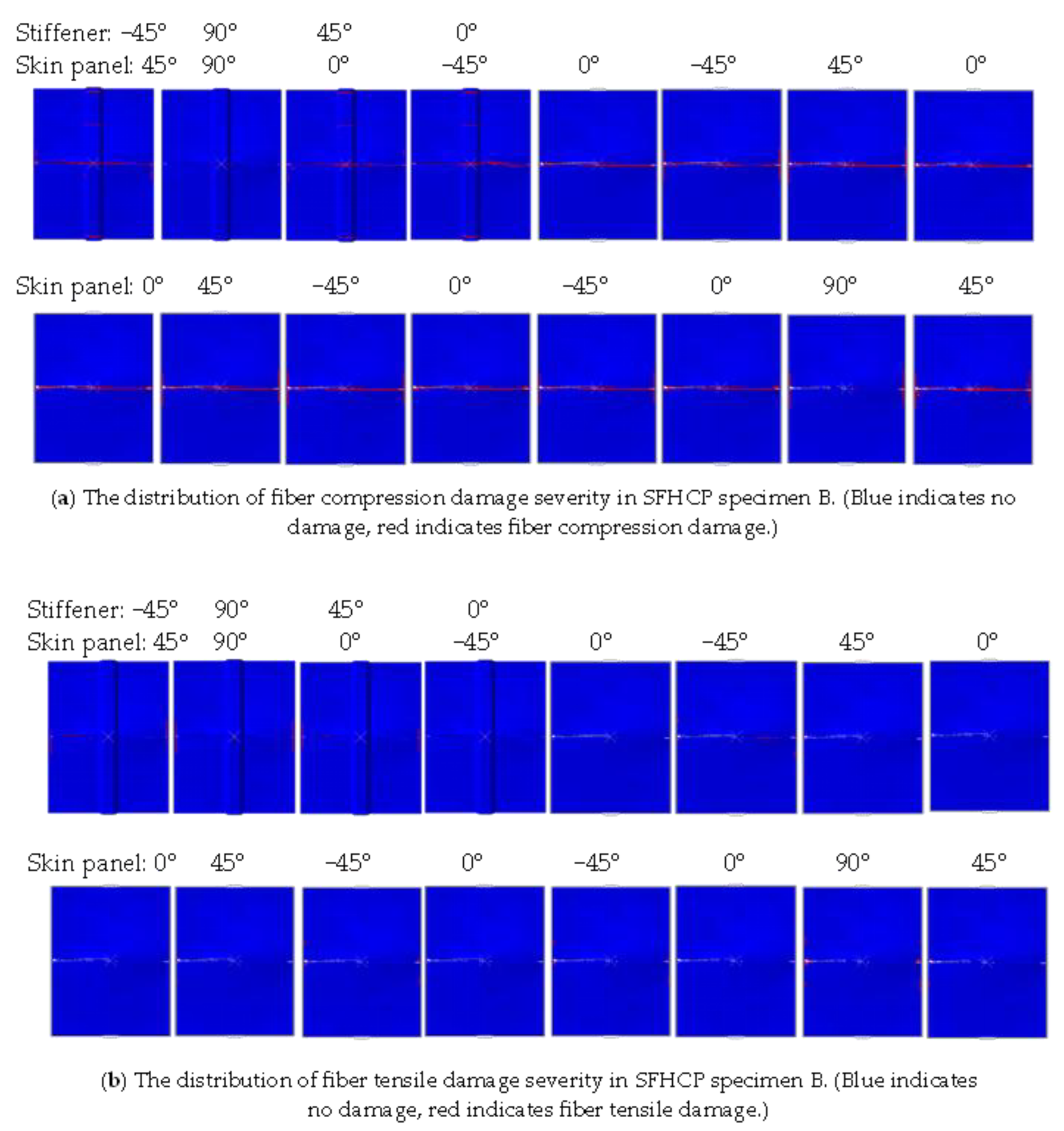4.1. Finite Element Model
Based on the ABAQUS (6.14-4) numerical simulation software, a low-velocity impact model and a CAI finite element model were established, and the finite element method was used to investigate the internal damage of symmetric composite stiffened panels during the impact process. Hashin failure criterion [
32] was used to analyze the damage evolution and fracture of symmetric composite stiffened panels after impact compression.
The stiffened panel consists of the skin, stiffener, foam core, and filler. The skin layup is [45/90/0/−45/0/−45/45/0]S, and the stiffener layup is [−45/90/45/0]. The skin and stiffener each have a layer thickness of 0.125 mm. The entire SFHCP specimen was modeled, with the dimensions and layup of each component being identical to the actual specimen. An integrated modeling approach was adopted because the use of traditional shell elements together with cohesive elements has been proven to be the fastest method and the relative error of CAI strength is relatively low [
33]. Zero-thickness cohesive elements were inserted between all connected components. In this study, SR4 elements were used for modeling the stiffener and skin, C3D8R solid elements were used for modeling the foam core and R-region filler, and COH3D8 cohesive elements based on the traction-separation model were used to simulate the interfaces between the stiffener and skin, and between the foam core and R-region filler. The hat-shaped stiffener was filled with a foam core, and the bottom of the foam core was filled with R-region filler. A “tie” binding connection was used between different components. The interface parameters are shown in
Table 2, and the elastic and strength parameters of the single-layer board are presented in
Table 3 and
Table 4, respectively. Where
Kn is the normal stiffness,
Ks and
Kt are both tangential stiffnesses of the cohesive manufacturer’s SFHCP specimen design.
tn0,
ts0, and
tt0 and
GnC,
GtC, and
GsC correspond to the ultimate strength and fracture toughness of the interface layer in the three directions at the beginning of the cracking process, respectively.
E1,
E2, and
E3 are the elastic modulus along the fibers in the plane, the elastic modulus perpendicular to the fibers in the plane, and the elastic modulus in the thickness direction, respectively.
G12,
G13, and
G23 are the three shear moduli, and v12 is the in-plane Poisson’s ratio.
Xt,
Xc, and
Yt, and
Yc,
Zt, and
Zc represent the tensile and compressive strengths in the three directions, respectively.
S12,
S13, and
S23 are the shear strengths in the three directions. The FEM boundary conditions are set such that the
Uy component is constrained on both sides.
Figure 6a shows the boundary conditions for the finite elements of the SFHCP specimens. At the same time, the fixed constraints of
Ux = Uy = Uz = 0 and
URx = Ury = Urz = 0 are applied at the fixed end. The displacement load
Uz is applied at the loading end with the constraints
Ux = Uy = 0 and
URx = Ury = Urz = 0.
When meshing the model, considering the accuracy of the numerical simulation results and the size of the computational scale, the dimensions in the FEM are the same as those of the actual SFHCP specimens. The overall mesh of the model is uniformly divided, with a mesh size of 5 mm for the skin panel and hat stiffener, resulting in 19,646 elements and 43,508 nodes. The foam core has a mesh size of 3 mm, and there are slight variations in mesh size at the corners of the stiffener, resulting in 167,340 elements and 199,948 nodes. The impact of finite element meshing of the SFHCP specimen is shown in
Figure 6b.
To make the finite element simulation results more accurate, a strategy that combines optical measurement data to gradually improve the FEM was established. The entire analysis process of the FEM is detailed in
Figure 7.
Step 1, obtain the SFHCP specimen dimensions and material parameters from the manufacturer’s SFHCP specimen design, and refer to the relevant literature on CFRP [
34,
35] to obtain material elastic parameters as a reference. Based on the specimen dimensions and material parameters, and considering the actual boundary conditions under the experimental setup, establish a FEM. Before the formal experiment, use this model for preliminary calculations to obtain the buckling load and ultimate load of the SFHCP specimen, which will be used to guide the design of the fixture and the formulation of the loading scheme.
Step 2, after the formal experiment, the existing FEM is improved by combining the symmetric buckling mode diagram obtained from FPP. Considering that the initial buckling mode of the stiffened panel often directly affects or even determines its post-buckling mode, and compared with the complex and tedious post-buckling analysis, the initial buckling mode can be conveniently and quickly obtained through eigenvalue buckling analysis. Therefore, before the post-buckling analysis, the original FEM can be reasonably screened according to the initial buckling mode. Specifically, the buckling mode obtained from the eigenvalue buckling analysis of the original FEM is compared with the initial buckling mode obtained from FPP. If there are differences in the number of waves, waveform, symmetry, and buckling load, the original FEM is refined by screening material elastic parameters within the reference range and adjusting boundary conditions to assign different degrees of freedom to the skin/stiffener so as to finally obtain simulation results that match the actual initial buckling mode. Since only eigenvalue buckling analysis is needed to screen the parameters, the trial-and-error time is greatly saved, the computational efficiency is improved, and a FEM that is more consistent with the actual working conditions is obtained, effectively improving the analysis accuracy.
Step 3, the matched buckling mode is introduced into the improved FEM in the form of initial geometric imperfections, and then post-buckling analysis is carried out. In the post-buckling analysis, material stiffness degradation and geometric nonlinearity are considered. Incremental loading is used, and the laminated material parameters are read to calculate the stiffness matrix, stress, and strain. The failure criteria are applied to determine whether a failure occurs. If failure occurs, the stiffness matrix is degraded and the stress is updated; if not, the load is increased, and the same process is repeated until the structure loses its load-bearing capacity, at which point the analysis is considered complete.
The material elastic parameters and boundary conditions were updated through the FEM update scheme. The buckling modes obtained by the updated FEM and the original FEM are shown in
Figure 8. It can be seen that the buckling mode obtained by the updated FEM is closer to the measurement results of the FPP. The load–displacement curve obtained from the step-by-step loading simulation is illustrated in
Figure 9. The simulated ultimate load of 103.616 kN demonstrates a percentage error of 2.25% compared to the experimental measurement (106 kN) from FPP. Not only are the number of waves four but the wave packets are also concentrated in the center of the panel, away from the side edges. During the compression process, the boundary conditions were updated to restrict the out-of-plane displacement on both sides, with one end fixed and the other end subjected to compressive displacement load. The specific material’s mechanical properties are shown in
Table 5 and
Table 6. Among them,
Table 5 lists the elastic parameters,
Table 6 lists the strength parameters, and
Table 7 includes the interface parameters [
36].
In
Table 5,
Table 6 and
Table 7, EX and EY are the modulus of elasticity of the composites in the two main directions of elasticity, GXY is the shear modulus of elasticity in the two main directions of the surfaces, PRXY is the Poisson’s ratio in the two main directions of the surfaces,
Kn is the normal stiffness, and
Ks and
Kt are the tangential stiffness of the cohesive interfacial layer.
tn0,
ts0, and
tt0, and
GnC,
GtC, and
GsC correspond to the ultimate strength and fracture toughness of the interfacial layer in three directions, when it starts to crack, respectively, and can provide directions related to when the interfacial layer starts to crack.
The low-velocity impact damage process of the stiffened panel was simulated using Abaqus/Explicit. The impact location was the symmetric center position on the hat-stiffened side of the foam core region, corresponding to SFHCP specimen B. During the impact process, frictionless hard contact was defined between the outer surface of the impactor and the impacted side of the skin, and the four sides of the skin and stiffened panel were fixed. The impactor was a steel punch with a radius of 12.7 mm, and C3D8R elements were used. The foam core material only has an impact damping effect, without considering stiffness reduction. In ABAQUS finite element software, the restart method was used to introduce the impact results as the initial state for the post-impact compression calculation, and the mesh division was consistent with the impact model.
4.3. Post-Impact Compression Damage Analysis
The buckling mode of the stiffened panel is closely related to the spatial distribution and temporal evolution of low-velocity impact damage on the stiffened panel [
26,
37].
Figure 11 shows the simulation results of the damage distribution of each layer of the undamaged SFHCP specimen A after compression failure. From the optical measurement results, it can be seen that when SFHCP specimen A withstands the ultimate load, the maximum deformation is concentrated in the middle region of the stiffened panel. The wave peaks and troughs on the panel alternate, which aligns with the finite element simulation results. This indicates that the compressive energy is effectively distributed across the buckling of the entire panel, confirming the soundness of both the geometric structure and the laminate design. As can be seen from
Figure 11, the damage areas are mainly concentrated on the first four layers of the skin and stiffener, which are integrated, and on the flanges of each layer of the panel, and the damage areas are relatively symmetrically distributed with respect to the two horizontal and vertical central axes. In the figure, the symmetry of the damaged regions is determined by the specimen’s symmetric stacking sequence and buckling mode. Moreover, interlayer damage tends to occur in areas with severe buckling, such as within the stiffeners and the panel. In contrast, the densely distributed damage along the boundaries is caused by the combined effects of composite material boundary phenomena and the strong constraint forces that suppress out-of-plane displacement (buckling). The main damage forms of the skin are matrix compression damage and fiber compression damage, while the stiffener has all four types of damage. Since specimen A did not undergo any impact, it incurred no initial damage, and the damage observed during the compression failure process was predominantly progressive in nature.
The reasons for the above phenomena are threefold: (1) The symmetry of the stiffened panel structure, load, and boundary conditions results in the overall symmetry of the damage distribution. (2) The stiffener has only four layers of ply, and these four layers are integrated with the first four layers of the panel. Under the condition that the stiffener bears most of the compressive load, the most severe damage occurs in these four layers. (3) The occurrence of more tensile damage in the last four layers of the skin is related to the fact that the first four layers of the structure experience more compressive damage and the final bending direction of the panel. Similarly, the areas of concentrated damage on the skin closely align with the regions of severe final deformation of the plate.
Figure 12 shows the simulation results of the damage distribution in SFHCP specimen B after CAI failure. From the optical measurement results, it is known that the stiffener of SFHCP specimen B has a certain pre-bending due to the impact, which leads to a very rapid failure process. This results in the failure of the stiffened panel being more towards “brittle fracture”, hence it is inferred that the damage of SFHCP specimen B has not spread over a large area. This damage is primarily caused by the initial damage from impact, with minimal progressive damage. Additionally, the buckling regions are observed to be concentrated near the stiffeners as the impact damage has weakened their stiffness. Compared to the undamaged specimen A, specimen B exhibits significantly lower compressive load-bearing capacity. This can be explained by the panel’s buckling failure mode, as the stiffeners play a crucial role in determining the compressive load-bearing capacity of the stiffened plate. As can be seen from
Figure 12, the damage area of this SFHCP specimen is relatively small. These damage areas are mainly concentrated near the transverse central axes of each layer and the flanges of each layer of the panel, and the damage areas are symmetrically distributed relative to the two horizontal and vertical central axes. The symmetry of the damaged regions in the figure is not only determined by the symmetric stacking sequence and buckling mode of the specimen but also influenced by the distribution of low-velocity impact damage. As a result, the symmetry in the distribution of matrix tensile damage in specimen B is less pronounced. Since specimen B underwent direct bending failure during compression with minimal buckling, the interlayer damage was mainly concentrated along both sides of the central line of the stiffened plate. Additionally, as the fixture no longer constrained buckling at the boundaries, the damage distribution at the boundaries was significantly smaller compared to specimen A. The main damage form of the skin is matrix tension damage, while the main damage forms of the stiffener are matrix tension damage and matrix compression damage. Overall, the damaged area of specimen B is relatively small, with a large portion of the material remaining intact despite the specimen’s failure. This not only results in material waste but also leads to a lower load-bearing capacity. These findings indicate that specimen B exhibits extremely high impact damage sensitivity in the central region of the stiffeners on the foam core side.
Additionally, there was no significant expansion around the impact pit. The reasons for this phenomenon are threefold: (1) The impact damage to the stiffener affects both the material and structural levels, leading to significant changes in the buckling mode and damage distribution. (2) Since the main load-bearing fibers on the stiffener are broken due to impact, the primary forms of damage to the stiffener are matrix tension damage and matrix compression damage. (3) Because the stiffened panel did not buckle but was directly bent, the damaged areas of the material are almost entirely concentrated near the transverse central axis, and the impact damage along with other damages have hardly spread.
Three clear conclusions can be drawn from the simulation results of the above two SFHCP specimens: (1) Damage to the stiffener has a significant impact on the mechanical performance of the stiffened panel, which is consistent with the research conclusions of other scholars [
38]. The reason is that the stiffener is the main load-bearing structure in the stiffened panel, leading to its high sensitivity to damage. (2) There is often a significant difference in stiffness between the stiffener and the skin panel, and the bonding area between them is more prone to material damage and delamination. (3) The damage distribution of both SFHCP specimens is almost concentrated in the first five layers and the last five layers, with minimal damage in the middle eight layers, indicating that the material utilization rate of this stiffened panel is not high when used as a pressure-bearing structure and further optimization of the design is possible.




















